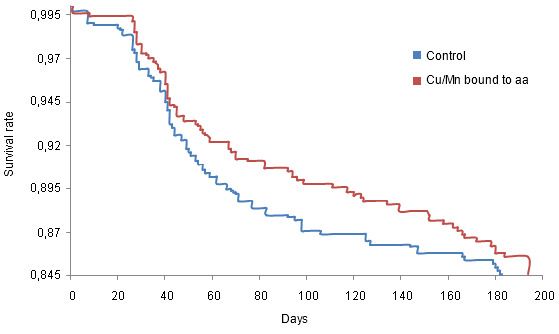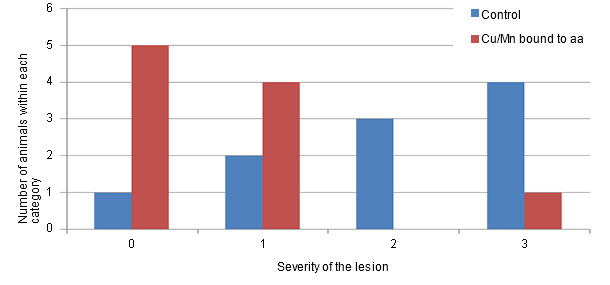At present the locomotive problems are the second cause for the culling of sows (sending them to the abattoir), representing about a 17% of the total, being the reproductive failure in the first place (approximately a 45%). Also, in the case of serious locomotive problems, the animals cannot be sent to the abattoir, and they must be put down at the farm, and this represents an increase in the mortality. In year 2013, with the implementation of the group housing, the sows will have to carry out movement and competition activities more frequently. With this new scenario, an increase in the removal of sows due to lameness problems is expected, with the subsequent decrease of their longevity and the costs that this entails. Some changes in the feeding can involve important improvements in the longevity of the sows.

Figure 1. Survival rate of the sows after the first parturition according to the diet.

The appearance of lameness depends not only on the feeding, but on other factors as, for instance, the housing systems or the genetics. The genotypes with a high prolificacy that have appeared in the last years suffer a higher wear and tear of the skeletal system due to the extra weight load and the higher production of foetuses and milk. On the other hand, the implementation of group housing can increase the heterogeneity of the weights, and those sows with a high weight can suffer an overload on their joints, whilst those sows with a very low weight are normally more fragile with respect to the aggressions. The ideal situation would be to keep the sows with a body condition (BC) score of 3 during the gestation, so it drops to 2.5 during the lactation and it recovers during the following pregnancy. In any case, BCs lower than 2 or higher than 4 should be avoided. Nevertheless, the management of the BC in the sows housed in groups, that go from eating some 7 kg of feed during the lactation to 2.5 kg during the gestation, is difficult. The restriction of the feed consumption applied in the group housing system entails an increase in the fights, and this, in turn, entails an increase in the lameness. In this case, the supply of roughage sources in the feed of the sows can help to keep them satisfied and reduce the fights. In this case, different roughage sources as a part of the concentrate have been studied, and some alternative experimental systems have tried, successfully, the providing of roughages given apart from the concentrate.
But the prevention of the lameness from a nutritional point of view should start with the correct development of the skeletal system of the replacement gilts. An excessive growth of the gilts can entail a bad development of the limbs and an excessive weight of the animals. In fact, most of the sows culled due to locomotive problems are normally first and second parturition sows with a bad development. So, it is important to review the feeding programs of the gilts, giving them diets that include their special requirements in terms of calcium, phosphorous and amino acids.
The sow must be able to store enough calcium during the gestation to face the possible mobilisations during the lactation. Nevertheless, it is important to keep the Ca/P ratio, because too little Ca could impair the absorption of P, and a low level of Ca reduces the accumulation of P in the bones. A recommendable Ca/P ratio would be 3:1. In this context, the use of phytases must be borne in mind in the calculations. Apart from Ca and P, other minerals must be considered in this balance. An acidosis (low blood pH) risk situation due to an excess of anions as, for instance, chlorine or sulphate, can reduce the bone development and even induce a loss of P and Ca from the bones in the long term. The excess of these anions can appear due to the use of some byproducts as, for instance DDGSs in which sulphuric acid has been used during the processing, and this can be compensated increasing the cations as, for example, Na or K.
On the other hand, there are evidences that show that the dose and the way in which other minerals (as Zn, Cu or Mn) are given have an effect on the incidence of lameness. In particular, the use of versions of these minerals bound to amino acids has shown some benefits when administered at the same doses than the inorganic forms.

Figure 2. Distribution of the severity of the lesions in the cartilage (scale from 0 to 3) of the control animals or of the animals fed a diet with Cu/Mn bound to amino acids.
With respect to the amino acids, some experiments prove that diets relatively poor in lysine during the development of the gilts may be beneficial to reduce the incidence of lamenesses. This effect is explained due to a lower development of the lean tissue mass of the animal, that will be kept during the following oestrus cycles, and this will reduce the weight to be borne by the animal. This effect is being studied in a more detailed way, but it can become dangerous up to a point, because the sows with a lower lean tissue mass may seem to have a lower BC score and they may be overly fattened involuntarily.
Finally, little is known about the effect of the vitamins on the appearance of lameness. A biotin deficiency could favour the appearance of lameness, because it is a vitamin that is implied in the correct formation of the hooves. It would be recommendable to use a dose of 400 μg/kg in sows housed in groups. On the other hand, a vitamin A excess (> 20,000 UI/kg) should be avoided, because it could interfere on the normal development of the bone.


